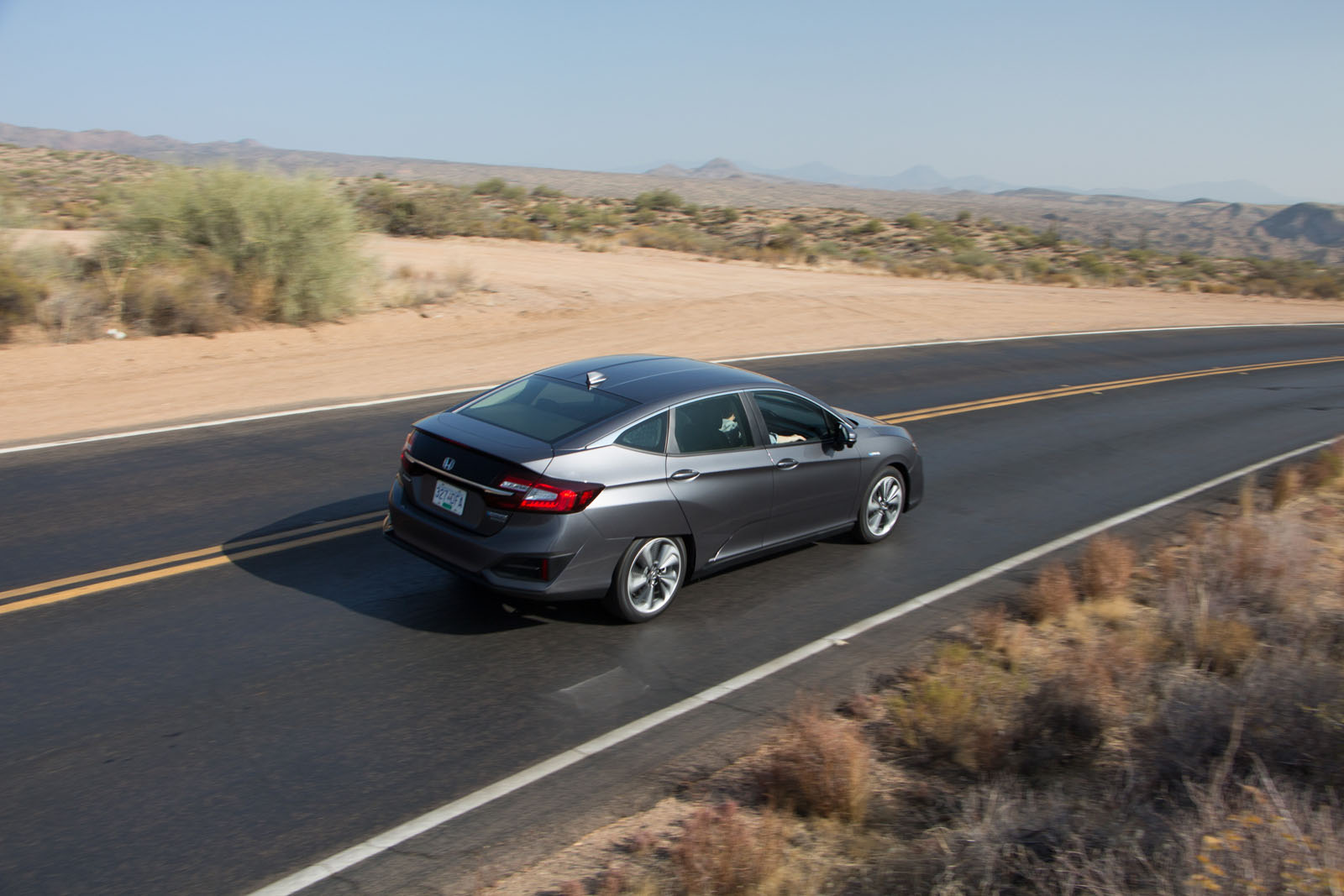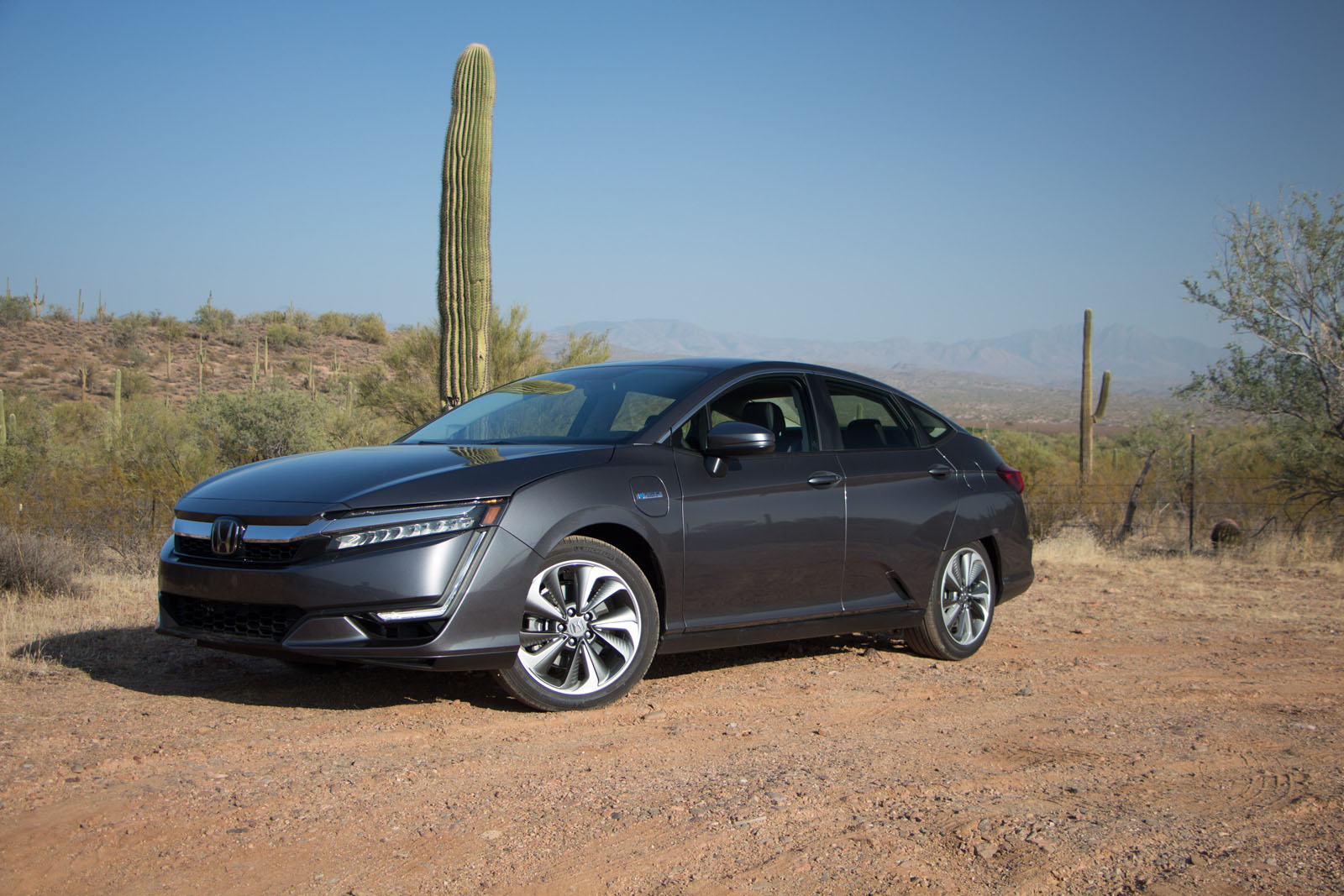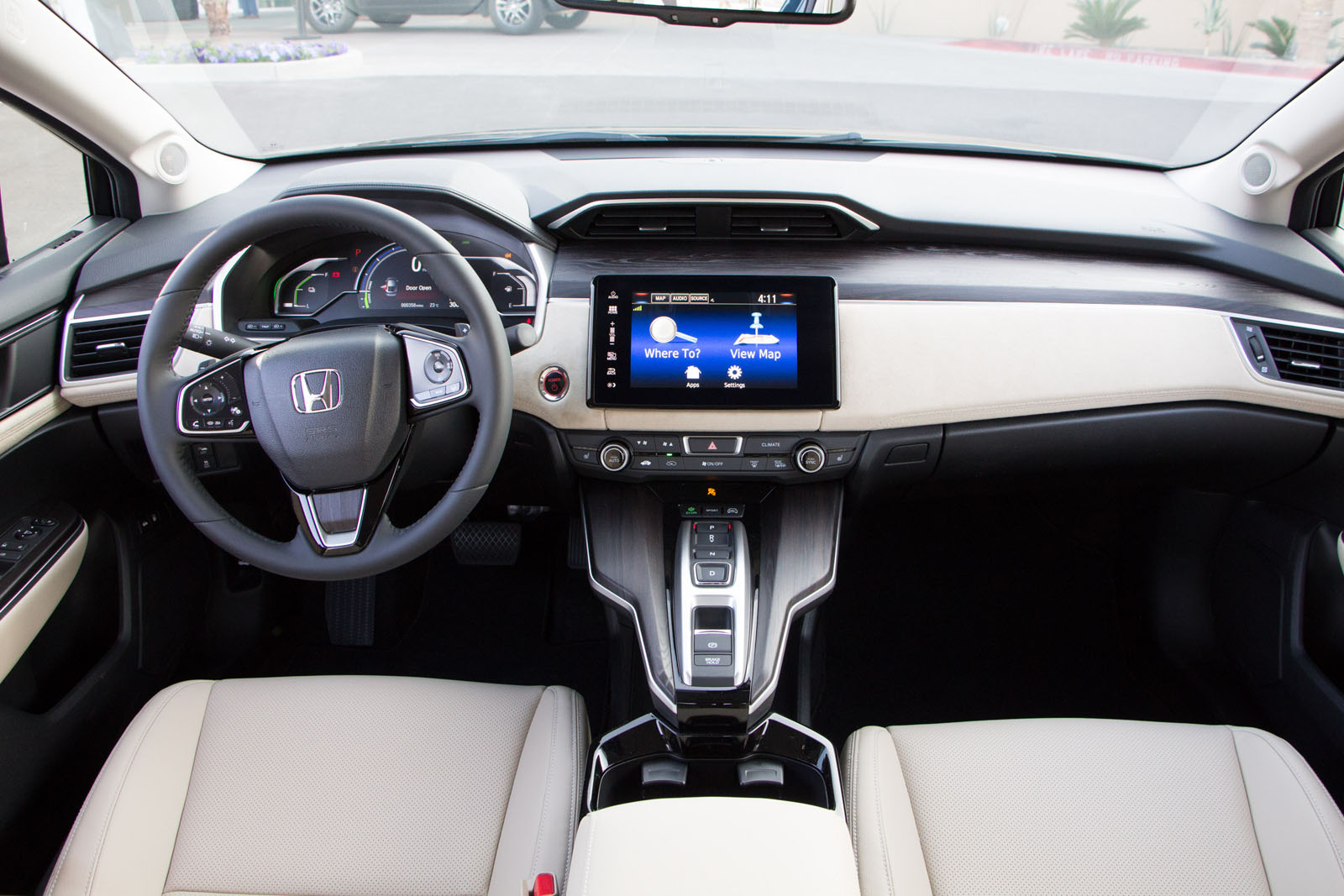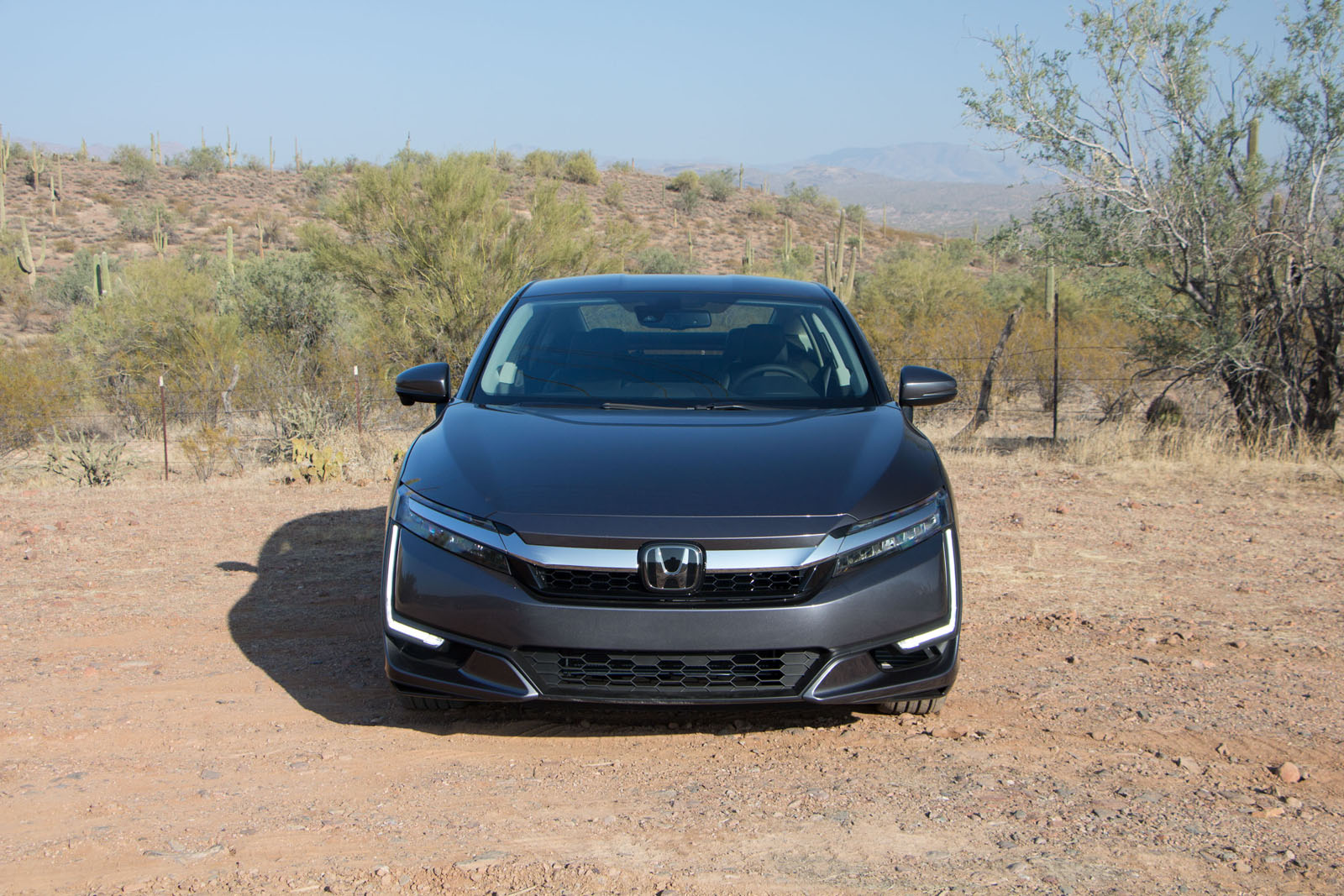The 2018 Honda Clarity is the brand’s latest purpose-built hybrid. It follows in the path of the two generations of Insight, but unlike the two Insights, this one has its sights set a little more in the mainstream.
This one wants to be your family car, not your compact commuter. So how does it stack up as a midsize sedan and as a fuel economy champ?
This isn’t the first car to wear the Clarity badge. The first was a funky fuel cell-only car that sold in very limited numbers from 2008 to 2014. This one will be available as a fuel cell vehicle and a full EV in certain U.S. markets, on top of the plug-in hybrid that will be available everywhere.
Practical Like an Accord
The Clarity is a big sedan, almost deceptively so. It comes within a hair of the new Accord in just about every dimension. That gives the Clarity space for four passengers in comfort or five in a pinch. Honda put the big 17-kWh battery pack under the seats, but the Clarity only gives up 0.35 inches of headroom to the Accord in the front and 0.25 inches in the rear. It’s the same impressive packaging that gives the Fit its cavernous storage space. Even passengers well over six-feet tall should find the car roomy.
Putting the battery under the floor means that cargo space is still a generous 15.5 cubic feet. Again, just less than the Accord. The long tail of the Clarity looks like it could be hiding a hatch, but it’s a conventional trunk. The large opening leaves a lot of room for getting things in and out, and the seatbacks fold for longer items. The pass-through is on the smaller side, though, so items that are big and long might not quite fit.

Inside, the Clarity has some nice touches that are new to Honda. Touring models come with Ultrasuede panels on the doors and across the dash. The wood trim is equally impressive — it’s not real wood, but instead of the artificial-looking veneers found in most cars, the Clarity’s trim replicates open grain wood trim found on high-end luxury cars. Even the base model has this trim, and the combination makes for a cabin that feels warm and inviting. The extra storage tray under the shifter means there is a lot of space for the junk that always piles up in the center console. The rear seats have extra pockets to hold a smartphone.
Impressive Powertrain
While the packaging is impressive, the real big deal here is the hybrid powertrain. It uses a 1.5-liter Atkinson cycle four-cylinder, based on the same engine as the Civic, along with a pair of electric motors — one that is a motor generator and one that’s just a generator. The combination makes 212 horsepower and 232 pound-feet; 181 hp from the motor and 103 from the engine.
ALSO SEE: 2018 Honda Accord Review
But the Clarity’s hybrid system only links the engine to the pavement in very limited drive modes. When cruising on the highway at low loads, a set of clutches can engage to use the gas engine to drive the front wheels directly. There is no transmission, so it’s a direct drive. In that mode, the Clarity is able to use just the gas engine when it’s more efficient to do that.
In most conditions, the electric motor supplies all the driving force. If the battery is low or if you floor it, the gas engine is used to make electricity to charge the battery and provide power directly to the motor.
It makes for a strange sensation that can see the gas motor change rpm independently of what your right foot is doing. It will rev up and down based on electrical requirements, which isn’t always how hard you want to accelerate. The engine is very quiet, blocked by extensive insulation, so you really have to listen to hear it when it’s on.

Driving Impressions
The Clarity has Eco and Sport driving modes, where the amount of pedal travel required to engage the gas engine goes up or down. You can’t lock it into EV mode, but a change in pedal feel when you get to the threshold of gas engine engagement makes it easy to keep it in EV mode yourself. Keep the pedal off the floor and it will stay in EV until the battery runs down after about 47 miles (76 km).
There are two HV modes that help the driver manage the battery. The first HV mode holds the battery charge level, using the gas engine more frequently to do it. That’s good if you’re on the highway and want to save the battery range for when you arrive in town. The second mode will work to recharge the battery. Again, it’s good to use if you’ve used up the charge but want EV mode later on in your trip.
ALSO SEE: 2017 Hyundai Ioniq Electric Review
The Clarity has a small seven-gallon gas tank, but the overall range is still an adequate 340 miles (547 km). Although that’s if you run the gas tank dry. Fill up before the low fuel light comes on and expect a much shorter range. But that’s not the point. This is supposed to be an EV most of the time, that will always get you home if you decide to go further. The small tank means more frequent stops on long trips, but the battery range lets the average person drive all week just using electricity.
Underpinning the Clarity is a front strut and rear multilink suspension. This is a heavy car, tipping the scales at 4,070 lbs (1,846 kg), but it manages to feel lighter thanks to Honda’s usual excellent suspension tuning. It drives more like a Civic than something that is nearly two tonnes.

The steering lacks feel and is heavily assisted, but it’s still direct and the Clarity turns in responsively. The ride is soft and comfortable. Even on the heavily cracked highways of our Arizona test route, the sharp bumps and gaps in the pavement were absorbed with little more than a thump from the tires. The turning circle is excellent, which is more important for a car like this than clipping apexes.
Visibility is excellent despite the steeply raked rear glass. That’s because Honda has given the Clarity a second window in the trunk lid. There is a small strip of glass directly behind the rear seat, and that gives you a sightline that lets you see objects surprisingly close to the back of the car.
The Clarity is impressively quiet. Even with the gas engine operating, powertrain noise is barely above a whisper. In town, most of the noise you’ll hear is from the cars around you, and wind noise is low, even at highway speed.
Both the base and Touring trims come with Honda Sensing active safety features standard. That includes radar cruise control with low-speed follow, lane keeping assist, and Honda’s LaneWatch blind spot camera.
Both Claritys get 18-inch alloys with an aerodynamic cover that pulls air out of the wheels to reduce drag. There is also push-button start, an eight-speaker stereo, and an 8.0-inch display with Apple CarPlay and Android Auto connectivity. The Touring adds satellite navigation, leather seats, the Ultrasuede dash trim, and satellite radio.
The big battery and smooth electric powertrain move the car briskly. And while you’re not going to win any stop-light drag races, there is enough power to make sure that off-ramps and city driving won’t be a problem.

Strange Styling
I’ve avoided talking about the styling so far, and there’s a good reason for that. Honda has tried oddball hybrids like the Insight, and it has tried incognito hybrids like the Civic and Accord. This one is firmly in the first camp. The square-jawed nose tapers back to a rear end that is more than a little reminiscent of the ungainly Crosstour. Combine that with the rear-door vents that help channel air around the rear wheels, and it’s not likely that anyone will call this a beautiful design. It is functional though, and the scoops really do help the Clarity eke out more distance per watt. As far as conspicuous hybrids go, this is certainly better looking than the Prius.
The Verdict: 2018 Honda Clarity PHEV Review
The Clarity is not a cheap car. It starts at $39,900 ($43,900 in Canada) for the Touring. If you live in a state or province that gives a rebate for EVs, this one will probably qualify for the full amounts because of that big battery. With the $14,000 rebate in Ontario, for example, that makes this car just under $26,000. And at that price, it feels like a steal. Even without that rebate, this does feel like a near $40,000 car.
If you’ve been EV shopping, but are worried about long trips, this could be your ideal car. The EV range will easily handle a day’s commuting and driving for most people, but when the battery runs low the fuel economy is still high thanks to the efficient gas engine. And if you turn the radio up and don’t watch the gauges, you’d be hard-pressed to tell it wasn’t a normal car. If you told me that this was the new Accord, I wouldn’t be surprised. And that’s a big compliment for the Clarity.
Discuss this article on our Honda Forum



Leave a Reply